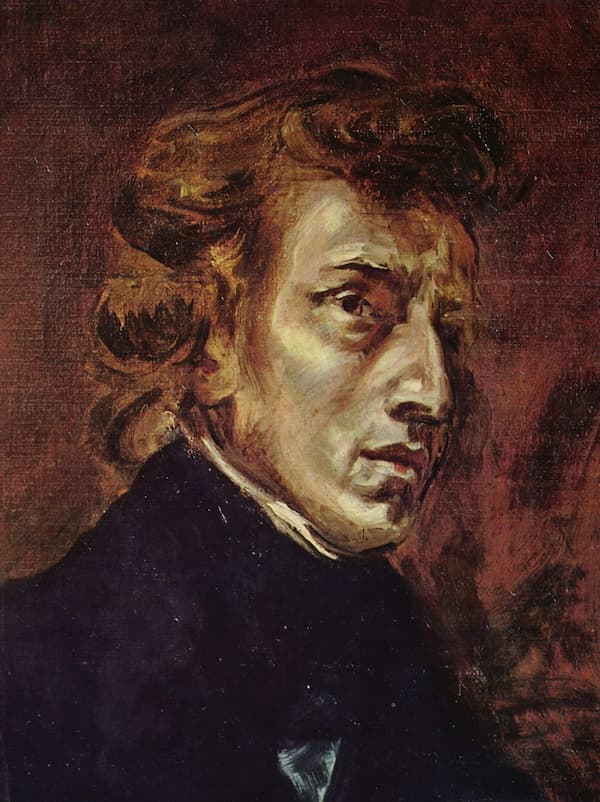Born on 3 February 1874 in Pittsburgh, Pennsylvania, Gertrude Stein was a central figure in the Parisian art world between 1903 and her death in 1946. Her Paris Salon at 27 rue de Fleurus “brought together confluences of talent and thinking that would help define modernism in literature and art.” Demanding novel forms of expression and a conscious break with the past, Stein helped to launch the careers of Henri Matisse, Juan Gris, Pablo Picasso, and entertained a steady stream of expatriate American and English writers, whom Stein dubbed “the Lost Generation.”
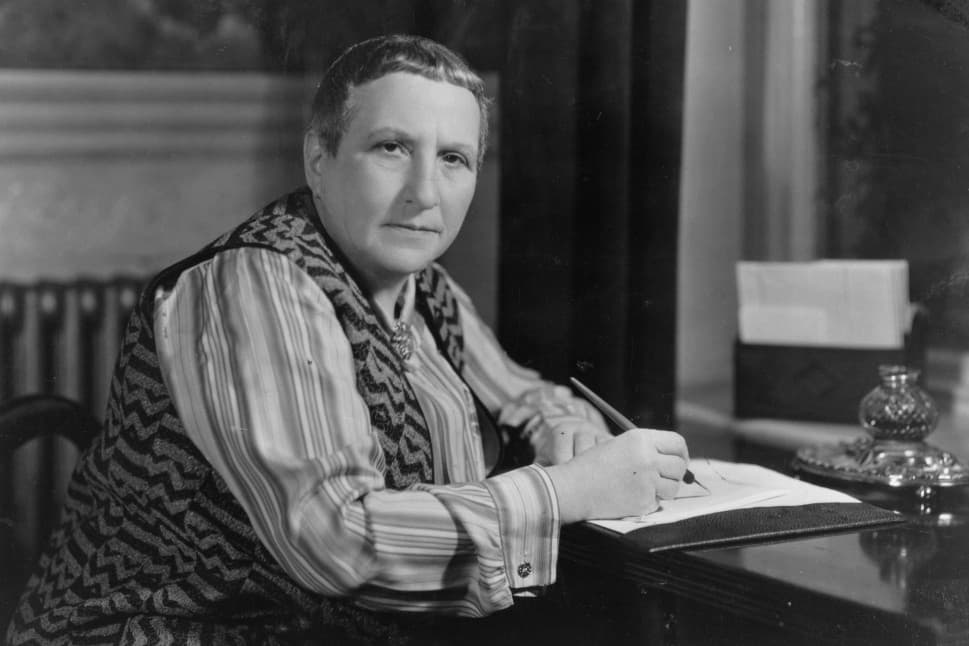
Gertrude Stein
A self-proclaimed genius, Stein was a bold experimenter in her writing. As a literary critic writes, “she rejected the linear, time-oriented writing characteristic of the 19th century for a spatial, process-oriented, specifically 20th-century literature. Her dense poetry and fiction, frequently devoid of plot or dialogue, contained memorable phrases that were not commercially successful.
Virgil Thomson: 5 Ladies “Alice Toklas”
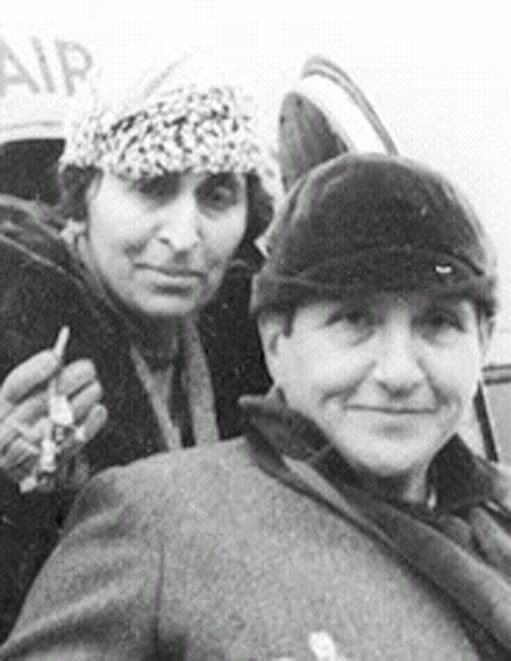
Gertrude Stein and Alice B. Toklas
Stein published her only bestseller, her quasi-memoir The Autobiography of Alice B. Toklas, written in the voice of her life partner Alice B. Toklas, in 1933. The style of that publication “is artful, consciously naïve, at times pompous, but it is never boring or obscure, and is often highly amusing.”
Virgil Thomson: 5 Ladies “Alice Toklas” (Philippe Quint, violin; William Wolfram, piano)
Virgil Thomson: Four Saints in Three Acts
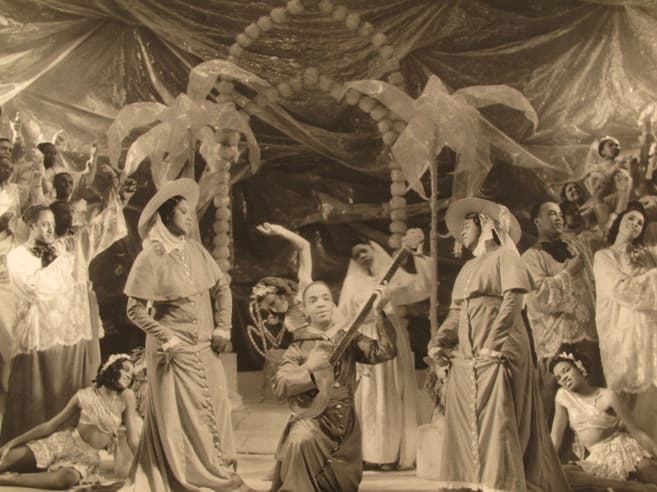
Virgil Thomson: Four Saints in Three Acts
Stein’s role as a literary figure has been relegated to a secondary role with a critic writing, “Most of us balk at her soporific rigmaroles, her echolalic incantations, her half-witted-sounding catalogues of numbers; most of us read her less and less.” However, Stein was an imposing figure, possessing remarkable self-confidence and a commanding manner. And she became the librettist for Virgil Thompson’s most famous opera Four Saints in Three Acts.
If a magpie in the sky on the sky can not cry if the
pigeon on the grass alas can alas and to pass the
pigeon on the grass alas and the magpie in the sky on
the sky and to try and to try alas on the grass alas the
pigeon on the grass the pigeon on the grass and alas.

Virgil Thomson
The opera composed in 1927 focuses on two sixteenth-century Spanish saints and their followers. The opening act takes place at the Ávila cathedral, the second involves a telescope and glimpses of a heavenly mansion, the third is a picnic, and the final act is set in the garden of a monastery.
Virgil Thomson: Four Saints in Three Acts (excerpts)
Born in Kansas City, Virgil Thomson graduated from Harvard University in 1923. However, it was his period of study in Paris during the early 1920s, when he was a student of Nadia Boulanger and met such seminal figures as Erik Satie and Jean Cocteau that determined his future direction as a composer. As a young man in Paris, Thomson became part of the intellectual and aesthetic debate, cross-disciplinary collaborations and inspiration, and intrigue. He became best friends with George Antheil, began his lifelong professional and personal relationship with the painter Maurice Grosser, avoided Ezra Pound, “and navigated a respectful rivalry between James Joyce and Gertrude Stein.”
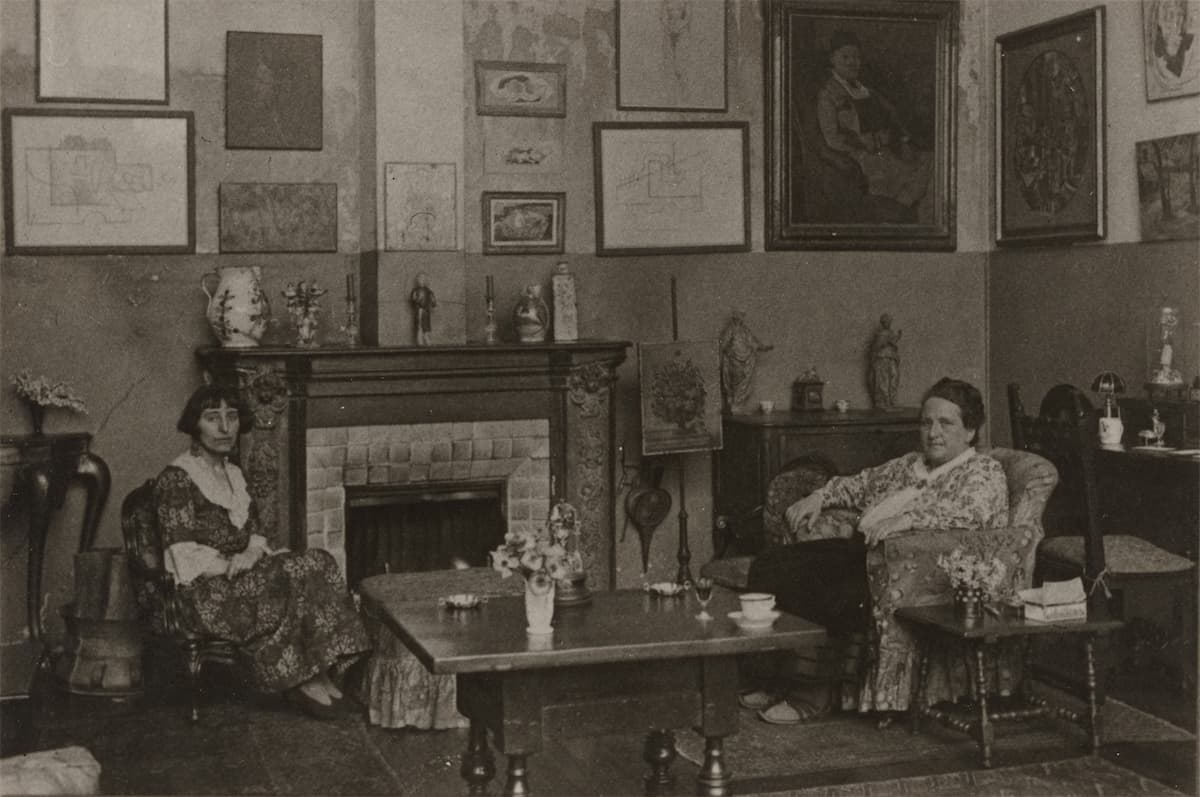
Gertrude Stein’s salon
Stein became one of his greatest friends and collaborators, and her unique poetic focus on word sounds over meaning inspired Four Saints in Three Acts and The Mother of Us All. Stein traveled to the United States to attend the premiere of Four Saints in Three Acts at the Wadsworth Atheneum in Hartford, Connecticut. She was treated to a groundbreaking production that featured an all-black cast, with singers directed by Eva Jessye, a prominent black choral director. Critics were divided, but audiences accepted the fantasy world created by the singers, “who vividly conveyed the words and melodies given to their saintly characters.”
Ricky Ian Gordon: 27

Ricky Ian Gordon: 27
Virgil Thomson famously said, “Every story that ever came from 27 rue de Fleurus eventually got told in Alice B. Toklas’ way, and that became its definitive version.” Toklas, in fact, was the hostess at all gatherings at the Stein salon. When a couple came to visit, “Stein typically entertained the men, while shuttling the wives off to sit with Toklas.” The Stein salon got started when people began visiting to see her newly acquired paintings of Matisse and Cézanne. Stein recalls, “Matisse brought people, everybody brought somebody, and they came at any time and it began to be a nuisance, and it was in this way that Saturday evenings began.” Picasso brought his mistress Fernande Olivier, Apollinaire attended with his mistress Marie Laurencin, Georges Braque mingled with Henri Rousseau, and Hemingway rubbed shoulders with F. Scott Fitzgerald and Sinclair Lewis. These colorful and influential meetings form the basis of the opera “27” by Ricky Ian Gordon. Commissioned by the Opera Theatre of Saint Louis and with a libretto by Royce Vavrek, the work premiered with Stephanie Blythe in New York City on 20 October 2016.
Ricky Ian Gordon: 27 – Prologue: Alice… – Knit, One (Elizabeth Futral, soprano; Stephanie Blythe, mezzo-soprano; Theo Lebow, tenor; St. Louis Symphony Orchestra; Michael Christie, cond.)
Ricky Ian Gordon: 27 – Act I Scene 2, Gertrude sits for Pablo: I have no talent for portraiture (Elizabeth Futral, soprano; Stephanie Blythe, mezzo-soprano; Theo Lebow, tenor; Tobias Greenhalgh, baritone; Daniel Brevik, bass-baritone; St. Louis Symphony Orchestra; Michael Christie, cond.)
Tom Cipullo: After Life

Tom Cipullo: After Life
Contemporary opera continues to be greatly inspired by the artistic and intellectual exchanges, real and imagined, originating during the famous Saturday evenings at 27 rue de Fleurus. American composer Tom Cipullo recently set to work on his opera After Life, which imagines an encounter between the ghosts of Pablo Picasso and Gertrude Stein. Picasso and Stein shared a similar background as both gravitated to Paris at the start of the twentieth century. “Both were brash modernists who exerted an outsized influence on their contemporaries.” Stein was an early champion of Picasso’s work, and he painted a well-known portrait of her. Theirs was a complicated friendship that lasted for decades, despite strong disagreements over politics. Cipullo “imagines how Stein and Picasso might have resumed their conversation if they confronted each other in our times. Would either of them look back and reconsider their artistic or political ideas? How would they react to the ways in which the world had come to see them and their work? Would either of them recognize their own ego and vanity, and would they contend that arrogance was integral to their genius?”
Tom Cipullo: After Life – But Picasso gave birth to himself (Robert Orth, baritone; Catherine Cook, mezzo-soprano; Music of Remembrance; Stilian Kirov, cond.)
Tom Cipullo: After Life – Miss Stein, I remember (Ava Pine, soprano; Robert Orth, baritone; Catherine Cook, mezzo-soprano; Music of Remembrance; Stilian Kirov, cond.)
Lord Berners: A Wedding Bouquet
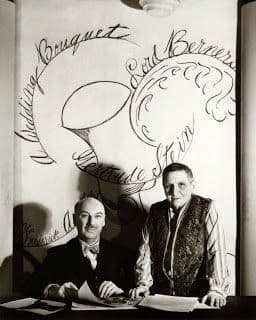
Lord Berners and Gertrude Stein
Colorful personalities attract colorful personalities. And one such character was undoubtedly the Right Honourable Sir Gerald Hugh Tyrwhitt-Wilson, later to be known as Lord Berners. Educated at Eton, and later in Dresden, Vienna, France, and Italy, he was groomed for diplomatic service, but when he inherited several country estates, he colorfully cultivated his literary, musical, and painting talents. His life motto is inscribed in his personal epitaph:
Here lies Lord Berners,
One of the learners.
His great love of learning
May earn him a burning.
But Praise to the Lord!
He seldom was bored.
Igor Stravinsky praised Lord Berner’s compositions, and A Wedding Bouquet is undoubtedly Berners’ most original and successful work. Originally, Berner was looking to compose a choral concert piece based on the opening pages of Gertrude Stein’s play “They must be wedded to their Wife.” After consulting personally with Stein, who added Pepe, her Mexican dog to the play’s characters, the original production featured ten solo singers from the opera chorus. In the end, it turned into a ballet featuring a French provincial wedding at the beginning of the twentieth century. The central character is the slightly demented Julia, who, in bygone days, has been ‘ruined’ by the rakish Bridegroom and is now an embarrassment to him. After the festivities are over, she is left disconsolate, with only her dog to comfort her.
Lord Berners: A Wedding Bouquet (RTÉ Chamber Choir; RTÉ Sinfonietta; Kenneth Alwyn, cond.)
Peter Ablinger: Voices and Piano, “Gertrude Stein”

Peter Ablinger: Voices and Piano
The Austrian composer Peter Ablinger came up with the idea of taking actual spoken recordings of well-known celebrities and pairing them with newly composed music. Written for the pianist Nicolas Hodges, Voices and Piano is an extended cycle of miniature, eventually reaching about 80 pieces. The composer writes, “I like to think about Voices and Piano as my song-cycle, though nobody is singing in it: the voices are all spoken statements from speeches, interviews or readings. And the piano is not really accompanying the voices: the relation of the two is more a competition or comparison, with speech and music compared.” In fact, we might actually think of it in terms of reality and perception. Reality is encoded in the speech, and the piano part is “the analysis of the voice. In simple terms, music analyses reality.”
Peter Ablinger: Voices and Piano, “Gertrude Stein” (Nicolas Hodges, piano)
Don Walker: Gertrude Stein Songs
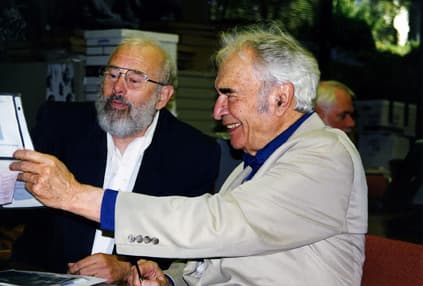
Don Walker and Dave Brubeck
American composer Don Walker has over 200 works to his name. These include 10 symphonies, 3 opera, piano, violin, and clarinet concertos, 14 string quartets, 14 piano sonatas, and more than 100 songs. These works make use of all available styles, from “aggressively dissonant to gently lyrical, often mixing the two in the same work.” Walker likes to embrace all styles and techniques, “as long as they produce music that is expressive and involving.” He counts Pablo Picasso, and his interest in setting up unexpected relationships between familiar things and abstractions, as one of his greatest influences. As he explains, “I have always sought to build abstraction from visually familiar attributes that functioned as points of reference designed to connect both his work and the listener with daily life.” Walker has a particular liking for using materials derived from other art forms, and from language. And that particular relationship comes strongly to the fore in his four settings of poetry by Gertrude Stein.
Don Walker: Gertrude Stein Songs (Ann Moss, soprano; Karen Rosenak, piano)
Brian Ferneyhough: Trittico per Gertrude Stein
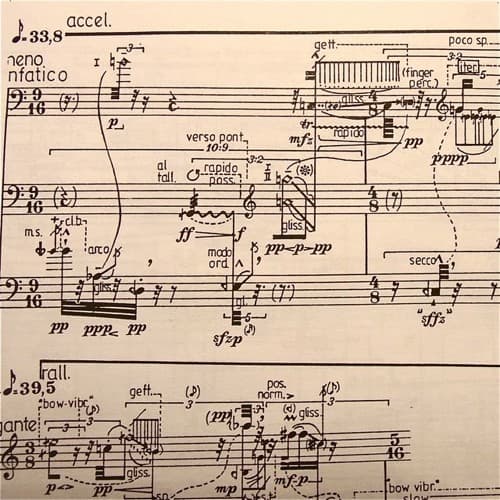
Brian Ferneyhough: Trittico per Gertrude Stein
Stein explained her literary approach as “continuous present is one thing, and beginning again and again is another. These are two things. And then there is the use of everything.” Although critics understood her approach, they remained largely skeptical of her ability to “reduce language to abstraction and still use it in a way that had meaning to anyone beyond herself.” It was said, “that Stein let the stream of her thoughts flow as if a book were only a receptacle for her mind.” For British composer Brian John Peter Ferneyhough, the process of composition appears remarkably similar. Ferneyhough “prefers to use systems only to create material and formal constraints, while their realization appears to be more spontaneous. He speaks of his music as being about creating energy and excitement rather than embodying an abstract schema.” As he writes, “Trittico per Gertrude Stein is based on a short extract from a lecture by Gertrude Stein on literary composition, and takes as its point of departure cyclic modes of transformation mapped onto three different types of musical material.”
Brian Ferneyhough: Trittico per Gertrude Stein (Stefano Scodanibbio, double bass)
John Cage: Living Room Music
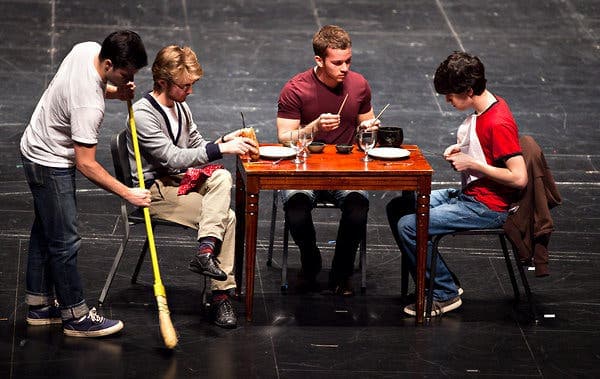
John Cage: Living Room Music
John Cage composed Living Room Music in 1940. Cage instructs the performers to use any household objects or architectural elements as instruments and gives examples: magazines, cardboard, large books, floor, the wooden frame of a window. In this quartet for unspecified instruments the first and last movements are percussive, but in the second movement, the performers transform into a speech quartet. The music consists entirely of pieces from Gertrude Stein’s short poem “The World Is Round,” spoken or sung.
Once upon a time, the world was round,
and you could go on it around and around
John Cage: Living Room Music: “Story” (Singer Pur)
Anne LeBaron: “Is Money Money”

Anne LeBaron © Adel Oberto
The American composer Anne LeBaron took Steins assertion “all the trouble comes from this questions, is money money,” as the basis of a composition for soprano, clarinet, bass clarinet, viola, cello, and contrabass, along with an assortment of call bells and ratchets. LeBaron selected texts from Stein’s poems “Money,” and “All about Money,” initially published in 1936.
All the trouble really comes from this question is money money
Everybody is always counting money.
The queen was in the parlor eating bread and honey
the king was in his counting house counting out his money.
Counting is funny
LeBaron considers this chamber music composition, and others in the same collection “self-contained musical memoirs. The work embodies a personal story, each came with its own challenge, and each challenge was met with an epiphany that led to a conceptual, stylistic, or technical breakthrough.” Maybe it is time to finish this article with another telling quote by Gertrude Stein, “ Whoever said money can’t buy happiness didn’t know where to shop.”
For more of the best in classical music, sign up to our E-Newsletter
Anne LeBaron: “Is Money Money” (Kirsten Ashley Wiest, soprano; Unearthly Delights Ensemble; Nicholas Jacobson-Larson, cond.)

